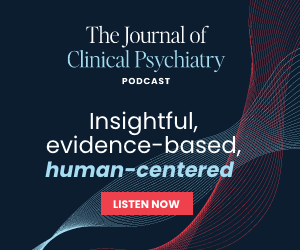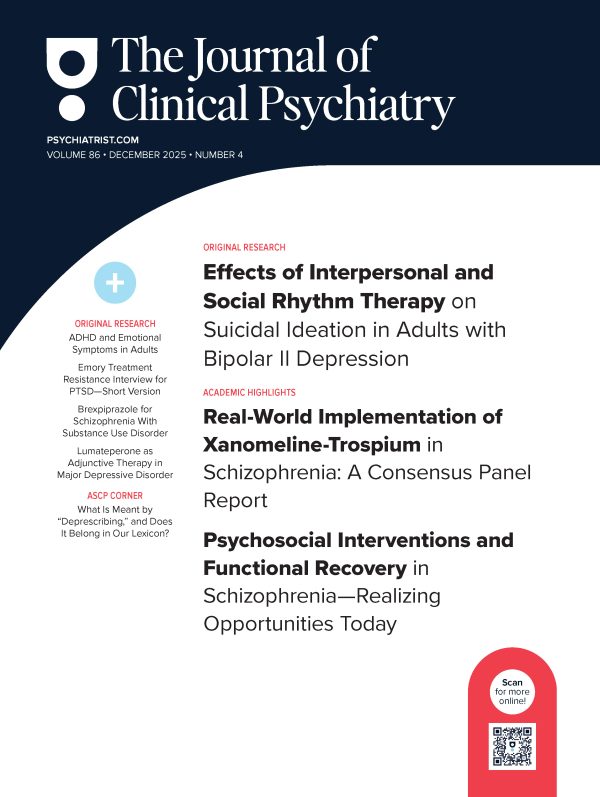This CME activity is expired. For more CME activities, visit CMEInstitute.com.
Find more articles on this and other psychiatry and CNS topics at The Journal of Clinical Psychiatry and The Primary Care Companion for CNS Disorders
Abstract
Many patients with bipolar disorder are initially misdiagnosed. Clinicians may incorrectly diagnose bipolar disorder as unipolar depression, borderline personality disorder, schizophrenia, anxiety, or substance use disorder. The consequences of misdiagnosis can include intensified manic symptoms, reduced quality of life, and increased risk of suicide. To correctly diagnose patients with bipolar disorder, clinicians must be aware of associated comorbidities and methods of differentiating bipolar disorder from other illnesses.
(J Clin Psychiatry 2009;70[8]:e26)
From the Department of Psychiatry, University of British Columbia, Vancouver, British Columbia, Canada.
Supported by educational grants from Eli Lilly and Company, Bristol-Myers Squibb Company and Otsuka America Pharmaceutical, Inc, and Pfizer Inc.
Although a correct initial diagnosis of bipolar disorder is crucial for optimizing treatment outcomes, many patients are not correctly diagnosed when first presenting with symptoms of bipolar disorder. Hirschfeld and colleagues1 found that 69% of patients with bipolar disorder were initially misdiagnosed, with as many as 35% of these patients being symptomatic for more than 10 years before receiving the correct diagnosis. Bipolar disorder overlaps symptomatically and is often comorbid with multiple psychiatric disorders, complicating the diagnostic process.2 Bipolar presentations share features with other psychiatric disorders including unipolar depression,3 borderline personality disorder,4 schizophrenia,5 anxiety, and substance use disorder (SUD).6 Further complicating diagnosis, some medical conditions such as circulatory disorders, migraine, respiratory disorders, epilepsy, and multiple sclerosis may manifest as similar symptoms or be more prevalent in patients with bipolar disorder.7
The consequences of misdiagnosis are important. For example, patients who are incorrectly diagnosed with a unipolar depressive disorder and then treated with antidepressants risk the intensification of manic symptoms8 and possibly increased suicidality.9 Delayed administration of a mood stabilizer has been associated with a decrease in the treatment’s efficacy and a 2-fold increase in the risk of suicide.10 Additionally, patients with undiagnosed and untreated bipolar disorder suffer a reduced quality of life and significant social/occupational impairment.11
Bipolar disorder is most frequently mistaken for unipolar depression.1 A major factor contributing to this common misdiagnosis is that patients with bipolar disorder often present with depression having failed to recognize, and underreported, their manic symptoms. Diagnosis of bipolar disorder can be improved if clinicians screen for mania and hypomania in patients presenting with depressive symptoms. Patients should be taught to recognize and track periods of racing thoughts, increased energy, and decreased need for sleep, which would indicate bipolar disorder as opposed to unipolar depression. Mood diaries or life charts may be an effective way for patients to track their moods. Supplemental information from a patient’s family and close associates may help to ensure a comprehensive diagnosis.
Bipolar disorder is also sometimes misdiagnosed as borderline personality disorder. The overlap between bipolar disorder and borderline personality disorder is such that some researchers wonder whether borderline personality disorder should be included in the bipolar spectrum.12 Currently, research indicates that borderline personality disorder and bipolar disorder are distinct conditions requiring differentiation.13 Four key areas can help clinicians distinguish bipolar disorder from borderline personality disorder.13 First, bipolar disorder has biphasic mood dysregulation, while borderline personality disorder has mood dysregulation in the depressive spectrum. Second, bipolar depressive symptoms meet the threshold criteria for major depressive disorder, while the mood symptoms in borderline personality disorder often do not. Third, patients with bipolar disorder experience improved interpersonal functioning during euthymia, but patients with borderline personality disorder continue to have interpersonal dysfunction during euthymia. Finally, patients with bipolar disorder are more likely to have a family history of bipolar or other mood disorders, but patients with borderline personality disorder often have a family history of deprivation and abuse.
Schizophrenia, anxiety, and SUD must also be differentiated from bipolar disorder. Goodwin and Jamison11 reported that at least 1 psychotic symptom was present in 58% of patients with bipolar disorder. In terms of anxiety, one study14 compared patients with obsessive-compulsive disorder with and without bipolar disorder, and those with bipolar disorder had a more episodic course, more episodes of depression, more sexual obsessions, fewer ordering rituals, a greater rate of panic with agoraphobia, and more abuse of different substances.
The differential diagnosis between bipolar disorder and SUD has a number of potentially distinguishing features.15 In particular, substance abuse is episodic when secondary to bipolar patients but continuous in SUD patients. Patients with bipolar disorder have mood problems (including mania or hypomania) in the absence of substance use, whereas patients with SUD may have substance abuse without mood problems. Finally, those with bipolar disorder are more likely to have a family history of bipolar or other mood disorders, while those with SUD have family histories of externalizing and anxiety disorders.
Comorbidity and symptom overlap with other conditions is so common in bipolar disorder that a comprehensive diagnosis demands great care. Misdiagnosis of bipolar disorder is frequent and the wrong treatment can exacerbate the illness, often contributing to a poor outcome and a decrease in patients’ quality of life. Clinicians must be acquainted with methods of differentiating bipolar disorder from those conditions for which it is commonly mistaken.
References
- Hirschfeld RM, Lewis L, Vornik LA. Perceptions and impact of bipolar disorder: how far have we really come? results of the National Depressive and Manic-Depressive Association 2000 survey of individuals with bipolar disorder. J Clin Psychiatry 2003;64:161–174
- Goodwin GM, for the Consensus Group of the British Association for Psychopharmacology. Evidence-based guidelines for treating bipolar disorder: recommendations from the British Association for Psychopharmacology. J Psychopharmacol 2003;17:149–173
- Akiskal HS. Searching for behavioral indicators of bipolar II in patients presenting with major depressive episodes: the “red sign,” the “rule of three” and other biographic signs of temperamental extravagance, activation and hypomania. J Affect Disord 2005;84:279–290
- Perugi G, Akiskal HS. The soft bipolar spectrum redefined: focus on the cyclothymic, anxious-sensitive, impulse-dyscontrol, and binge-eating connection in bipolar II and related conditions. Psychiatr Clin North Am 2002;25:713–737
- Taylor MA, Abrams R. Manic-depressive illness and good prognosis schizophrenia. Am J Psychiatry 1975;132:741–742
- Mitchell JD, Brown ES, Rush AJ. Comorbid disorders in patients with bipolar disorder and concomitant substance dependence. J Affect Disord 2007;102:281–287
- McIntyre RS, Soczynska JK, Beyer JL, et al. Medical comorbidity in bipolar disorder: re-prioritizing unmet needs. Curr Opin Psychiatry 2007;20:406–416
- Benazzi F. Bipolar disorder: focus on bipolar II disorder and mixed depression. Lancet 2007;369:935–945
- McElroy SL, Kotwal R, Kaneria R, et al. Antidepressants and suicidal behavior in bipolar disorder. Bipolar Disord 2006;8(5 pt 2):596–617
- Ben Abla T, Ellouze F, Amri H, et al. Unipolar versus bipolar depression: clues toward predicting bipolarity disorder [in French]. Encephale 2006;32(6 pt 1):962–965
- Goodwin FK, Jamison KR. Manic-Depressive Illness. New York, NY: Oxford University Press; 1990
- Deltito J, Martin L, Riefkohl J, et al. Do patients with borderline personality disorder belong to the bipolar spectrum. J Affect Disord 2001;67:221–228
- Paris J, Gunderson J, Weinberg I. The interface between borderline personality disorder and bipolar spectrum disorders. Compr Psychiatry 2007;48:145–154
- Perugi G, Toni C, Frare F, et al. Obsessive-compulsive-bipolar comorbidity: a systematic exploration of clinical features and treatment outcome. J Clin Psychiatry 2002;63:1129–1134
- Bizzarri JV, Sbrana A, Rucci P, et al. The spectrum of substance abuse in bipolar disorder: reasons for use, sensation seeking and substance sensitivity. Bipolar Disord 2007;9:213–220
Drug Names
No drug names were discussed in this activity.
Disclosure of Off-Label Usage
Dr. Young has determined that, to the best of his knowledge, no investigational information about pharmaceutical agents that is outside U.S. Food and Drug Administration−approved labeling has been presented in this activity.


